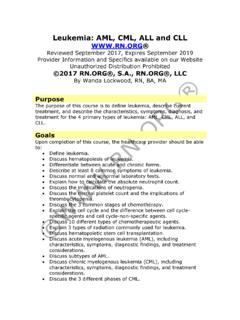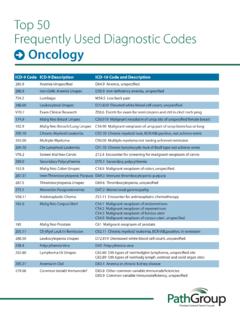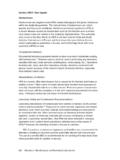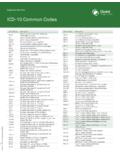Transcription of CAUSES OF LYMPHOCYTIC EXUDATIVE PLEURAL …
1 1. Dr. Rukhsana AnwarMCPS (Pulmonology), FCPS (Medicine)Pulmonology Department,Khyber Teaching Hospital, Peshawar2. Dr. Javed Iqbal FarooqiFCPS (Gastroenterology), FCPS (Medicine)Assistant Professor,Medical A Unit, Lady Reading Hospital, PeshawarCorrespondence:Dr. Javed Iqbal FarooqiHouse , Street ,Shami Road, Defence Colony,Peshawar Cantt, Peshawar, PakistanE-Mail: Received for publication:May 10, 20041st Revision received:August 19, 20042nd Revision received:November 1, 2004 Revision accepted:November 25, 2004 CAUSES OF LYMPHOCYTIC EXUDATIVEPLEURAL EFFUSION AS REVEALED BYPERCUTANEOUS PLEURAL BIOPSY:Experience From PeshawarAnwar R1 & Farooqi JI2 ABSTRACTO bjective: To find out the CAUSES of LYMPHOCYTIC EXUDATIVE PLEURAL effusion as revealed by percuta-neous PLEURAL biopsy, in of Study: It was a retrospective & Duration: The study was conducted on patients admitted in the Pulmonology Department,Khyber Teaching Hospital Peshawar and Medical A unit, Lady Reading Hospital Peshawar during Janu-ary to December : A total of 74 patients, aged 17 79 years with mean age 46 years, of either sex, withlymphocytic EXUDATIVE PLEURAL effusion, were enrolled in this study.
2 They underwent closed pleuralbiopsy with Abram s needle in standard way. An average of three biopsy specimens were obtained ineach patient, which were examined histopathologically. A retrospective analysis of the histopatho-logical reports was carried out, to find out the : In patients, definite histopathological diagnosis was possible whereas in nodefinite diagnosis could be made. Among the definite diagnosis group, were tuberculosis were : Among diagnosed patients, tuberculosis and malignancy were the most common causesof LYMPHOCYTIC EXUDATIVE PLEURAL effusion in our WORDS: PLEURAL Biopsy, EXUDATIVE PLEURAL Effusion, Tuberculosis, MesotheliomaPak J Med Sci January-March 2005 Vol. 21 No. 1 39-43 INTRODUCTIONL ymphocytic EXUDATIVE PLEURAL effusion isone of the most common medical problems. Ithas a wide spectrum of etiologies like tubercu-losis, malignancy, rheumatoid pleurisy, fungalpleurisy, sarcoidosis and even parasitic diseasessuch as echinococcus granulosis1-4.
3 Therefore,to find out the underlying cause in any par-ticular patient, proper diagnostic workup in-cludes clinical examination, X-Rays, pleuralfluid analysis and PLEURAL biopsy; the latter isthe investigation of choice in such cases. Thediagnostic yield of PLEURAL biopsy has been re-ported from 50% to 75% in different studies3,4, Francis and coworkers first pioneered pleu-ral biopsy in 1955, and this was followed threeyears later by introduction of Abrams and Pak J Med Sci 2005 Vol. 21 No. 1 39 Cope PLEURAL biopsy needles7-9. Diagnostic yieldof PLEURAL biopsy depends upon patient popu-lation, biopsy technique, number of biopsyspecimens, the expertise of operator and his-topathological analysis4. This study was car-ried out to find out the CAUSES of lymphocyticexudative PLEURAL effusion, as revealed by per-cutaneous PLEURAL biopsy, in our set-up(Peshawar).PATIENTS AND METHODSR ecords of 74 patients, admitted inPulmonology Department of Khyber TeachingHospital Peshawar and Medical-A Unit ofLady Reading Hospital Peshawar from Janu-ary to December 2003 were examined.
4 Thesepatients had undergone PLEURAL biopsy to findout the underlying cause of their lymphocyticpleural effusion. The data was analyzed to findout total number of patients, age distribution,gender distribution and histopathologicaldiagnosis as revealed by biopsy (definitive /inconclusive diagnosis). PLEURAL Biopsy: Prior to PLEURAL biopsy the pro-cedure was explained to the patient and in-formed written consent was taken. The patient,he/she was asked to be seated on a couch,leaning forward with arms across the chestplaced on shoulders, to easily access the poste-rior chest wall. Biopsy site was selected twointercostal spaces below the fluid level dem-onstrated on physical examination. Local in-filtration of 2% lignocaine was used to anes-thetize skin, subcutaneous tissue, muscle andparietal pleura. Skin incision was made withpointed surgical blade parallel to ribs. Two tofour, on average three, biopsy specimens wereobtained in each patient using Abrams pleu-ral biopsy needle in standard way, and placedin 10% formaldehyde.
5 In cases of large effu-sion, therapeutic drainage was also site wounds were sealed with sterilizeddressing technique afterward. In three patients,seepage of PLEURAL fluid from PLEURAL biopsy sitehad to be controlled with one or two stitchesof silk. A check chest X-ray, and homodynamicmonitoring was done in every case to look forcomplications. Biopsy specimens were sent forhistopathological analysis to know the under-lying cause of effusion RESULTSThe study-group included 74 patients, withmale to female ratio of approximately 2 age of the patients was 46 years. Depend-ing upon the results, the patients were dividedinto two groups: Group I comprised those patients who haddefinite histopathological diagnosis. Group II comprised those patients who hadinconclusive histopathological results of PLEURAL biopsyalong with sex distribution are mentioned intable : Distribution of histopathological lesions on PLEURAL biopsy (n = 74) LesionsNo.
6 Of Patients Sex-distributionDefinitive diagnosis53 ( )LesionsMalesFemalesTuberculosis25 ( )14 ( )Mesothelioma07 ( )01 ( )Adenocarcinoma03 ( )0 (-)Metastatic disease01 ( )0 (-)Lymphoma01 ( )01 ( )37 ( )16 ( )Inconclusive diagnosis21 ( )12 ( )09 ( )GRAND TOTAL74 ( )49 ( )25 ( )Anwar R & Farooqi JI40 Pak J Med Sci 2005 Vol. 21 No. 1 comprised 53 ( ) patients withmale to female ratio of approximately 2:1. Themean age was 49 years. The most commonaetiology was Tuberculosis ( patients)followed by Malignancy ( patients).GROUP II comprised 21 ( ) patients,with male to female ratio of :1. The mean age was 44 effusions are classified as either exu-dative or transudative depending on the con-centration of protein and LDH in the pleuralfluid. EXUDATIVE PLEURAL effusion has at leastone of the following three properties:1) PLEURAL fluid/serum total protein ratio > ) PLEURAL fluid/serum LDH ratio > ) An absolute value of PLEURAL fluid LDH >200 IUExudative PLEURAL effusion may be neutro-philic or LYMPHOCYTIC : Tuberculosis3,4,10,11, ma-lignancy10,11, lymphoma11, sarcoidosis12, andrheumatoid pleurisy3,4, are the common causesof the latter type.
7 According to Light RW etal13, when EXUDATIVE criteria are met by LDHalone, fluid leukocyte count is virtually neverdiagnostic, the diagnosis of malignancy orparapneumonic effusions should be yield of PLEURAL fluid analysis alonehas been reported to be low. Javed A, et al3reported 8% diagnostic yield of PLEURAL fluidanalysis in their 150 patients. Similarly CollinTR, et al5 reported 18% diagnostic yield of pleu-ral fluid analysis in their 125 patients. There-fore, percutaneous PLEURAL biopsy must becomplemented to PLEURAL fluid analysis to findout the aetiological cause of LYMPHOCYTIC exu-dative PLEURAL effusion, as suggested by SahnSA, et al14 and Goldman L, et al15 as wide range of diagnostic yield of pleuralbiopsy has been reported in literature. FishmanAP, et al1 reported 40% diagnostic yield of pleu-ral biopsy in their patients. Baum GL et 51% diagnostic yield of PLEURAL biopsyin their meta analysis of 14 studies including2893 patients.
8 However, in case of tuberculo-sis, diagnosis was based on histopathologicaland microbiological analysis. In patients whosehistopathology could not confirm diagnosis,culture of tissue fragments increased the po-tential for confirmatory diagnosis upto 60% ofcases. Khurram M et al4 reported 49% diag-nostic yield of PLEURAL biopsy in their 120 pa-tients. In our series, diagnostic yield of pleuralbiopsy was that is comparable with69% diagnostic yield of another local study byJavaid A, et al3 in their 150 patients. In our patients, histopathological diagnosis wasinconclusive, also comparable with the inter-national and local literature1,3,4,14,17,18, in suchscenario repeat biopsy is advisable4. To improvethe diagnostic yield of initial biopsy, it has beensuggested to take four or more biopsies3 andfrom the lowest PLEURAL margin19. Kirsch et al20also reported that the sensitivity of PLEURAL bi-opsy is highest when more than six specimensare obtained, which on average contain morethan two specimens of parietal pleura.
9 We ob-tained two to four, on average three, biopsyspecimens in each patient in standard to Shah NH et al21 in Pakistan,the main indication for PLEURAL biopsy is to di-agnose or exclude tuberculosis and malig-nancy. Tomlinson SR, et al6 reported diagnos-tic yield of 74% and 57% for tuberculosis andmalignancy respectively in their review of 1893pleural biopsies. In our series, tuberculosis wasthe most common cause, found in pa-tients followed by malignancy in pa-tients on PLEURAL biopsy, comparable with otherlocal studies. Khurram M, et al4 diagnostic yield for tuberculosis for malignancy in their 120 A, et al3 reported 45% diagnostic yieldfor tuberculosis and 24 for malignancy in their150 patients. Tubercle bacilli have been noto-riously difficult to culture from PLEURAL fluid,with a positive culture in only , diagnosis of tuberculosis PLEURAL ef-fusion is most often established by histologicalLymphocytic EXUDATIVE PLEURAL effusion Pak J Med Sci 2005 Vol.
10 21 No. 1 41examination of PLEURAL biopsy. In our country,all LYMPHOCYTIC EXUDATIVE PLEURAL effusions arepresumed to be due to tuberculosis and manyclinicians prescribe such patients anti-TB drugswithout going for any further approach needs to be given up, as at least1/3rd of such effusions are caused by malig-nancy, as found in our series as well as otherlocal literature3,4. Our reported diagnostic yieldof for malignancy is comparatively lowas compared to international studies22,23, whichsuggest diagnostic yield ranging from 30% to70%. This may be due to high prevalence oftuberculosis in our country, making frequencyof malignancy relatively histopathological report interms of chronic non-specific inflammation oracute on chronic inflammation is not uncom-mon. Capelozzi VI, et al24 reported chronicnon-specific inflammation in 34% of their 164patients. Similarly Abu-Shams K, et al25 re-ported chronic non-specific inflammation in33% of their 216 patients.





